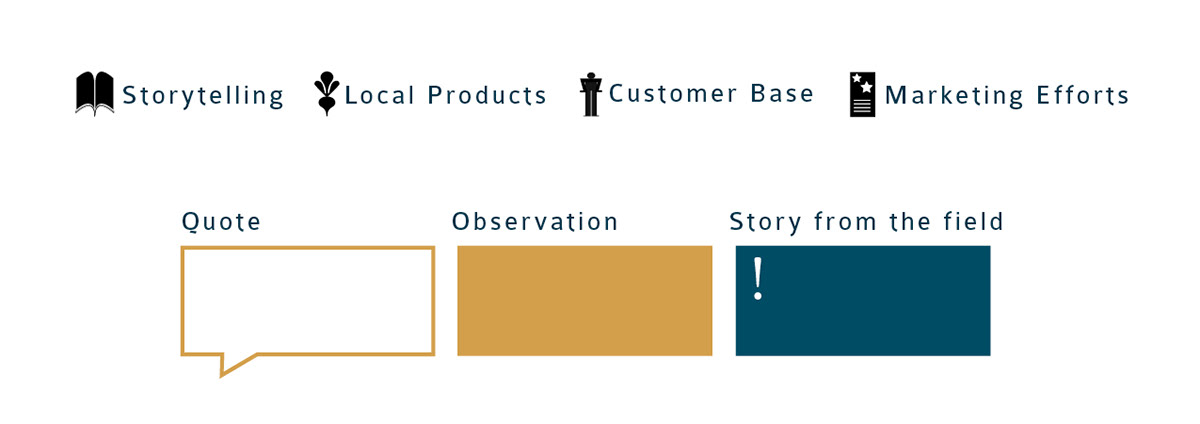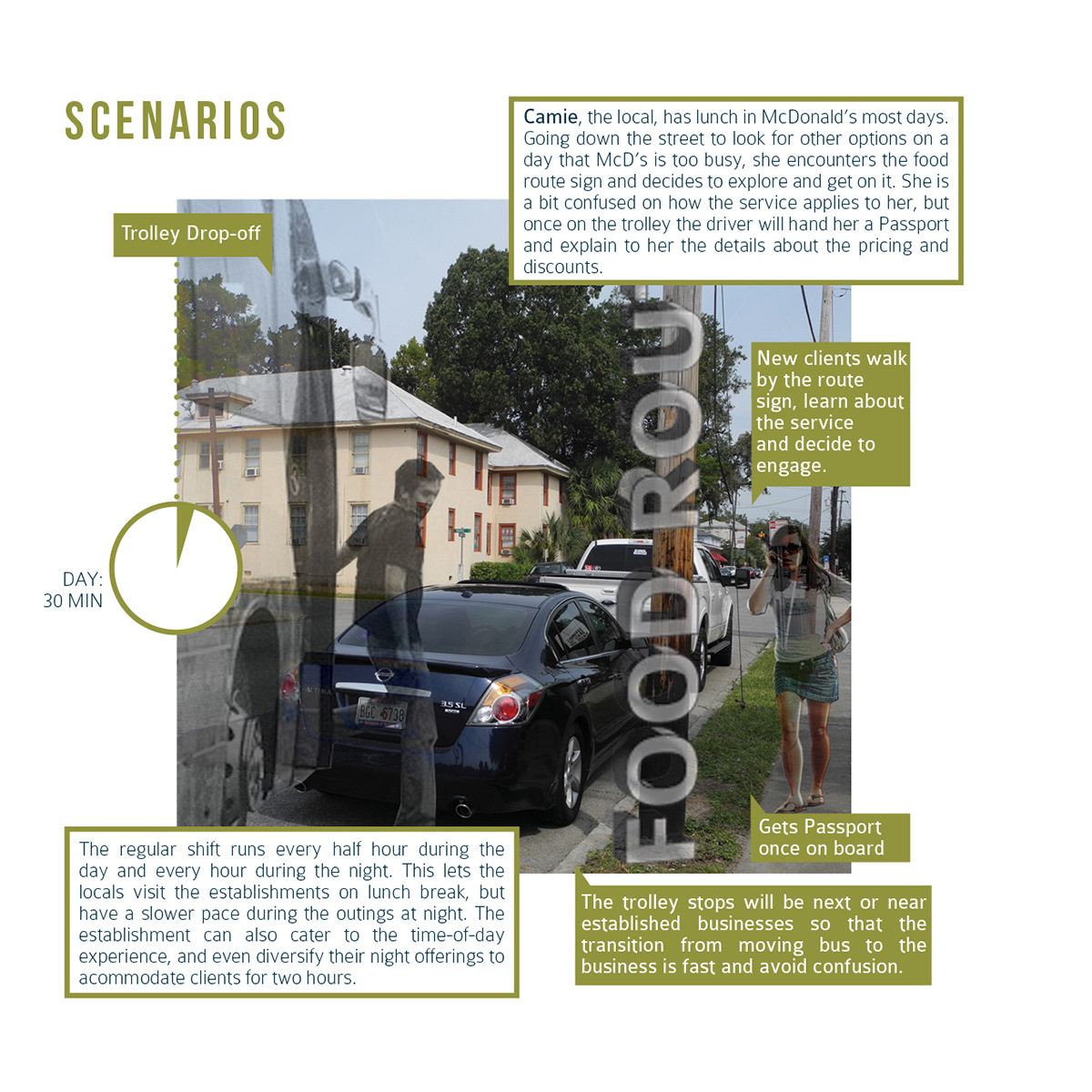


Background Info:
We began by identifying food establishments that could serve as case studies for exploring what we preliminarily considered “tourist” and “local” food experiences. For this we collected data by various non-participatory and participatory field research methods such as fly on the wall, shadowing, interviewing, and immersion into the Savannah food culture. Our case studies are:

We define a “food experience” as any interaction with a food establishment or food event in Savannah as to not limit ourselves to restauraunts. Within our exploration of the places above, we also want to specifically investigate the following characteristics of the experience:
the role of storytelling (authentic vs rehearsed) in the environment
potential use of local products and/or ingredients
their primary customer base, and ideal customer base
any exisiting marketing efforts (where/how/language used)

Project Scope:
We believe food experiences connect people, both local and visitors to Savannah, and we want to understand how. We seek to explore what we assume are “tourist” and “local” food establishments within the downtown area, and use our research to create a definition for both. We want to make connections between these experiences and see how either category might benefit from each other’s practices.
Research Questions:
1. What defines a local food establishment and a tourist food establishment? What lies in the middle? What defines experiences that can’t be categorized?
2. Do food establishments aim to cater to a specific experience and how? Do they/can they switch- is it conscious? Intentional?
3. How does an establishment’s products and marketing efforts reflect their target audience?
4. How do people’s food experiences reflect their status as a Savannah
resident or visitor?
Fly on the Wall
Observation of people in their context without any participation of the researcher for identifying patterns and behaviors. It minimizes potential bias or behavioral influences that might result from engagement with people, but might also reduces the researcher’s ability to connect empathetically with people and have a deeper understanding of the motivations behind their behaviors.
Shadowing
Non-participatory observation of a user, in which the researcher watches the user during normal activities and interactions to identify patterns and behaviors. These observations are conducted in the user’s actual workplace or home environment.
Participant-Observer
Observation in which the researcher becomes a participant in the activities being studied, and hence has the opportunity to empathetically learn by experiencing events first-hand. It leads to better access to the community and a more trusting relationship with other participants which results in more authentic behaviors on their part.
(Show me) Interview
Prepared questions are the base of a conversation where the interviewee is not only asked about his behavior but is able to demonstrate it for the researcher.
Co-Design
A tool that helps the team look for new points of view, new insights, opportunities for improvement, and different perspectives of our research from the actual players of the field.


The team chose thirteen food establishments in Savannah to research. At first glance some of these have predominant characteristics that appeal to a tourist market, while others focus on the local market. The distinctions between local and tourist are not as evident once the team enters the field. Relationships between how they portray their story, their efforts for being a locally resourced businesses, the local’s patronage and their tourist appeal, all arise during research to form a complex food experience system.


The Systems Map is a tool the team created to figure out how the field players and organizations relate.
We divided our systems map in four main clusters around the case studies: storytelling, product, customer base and marketing. With this tool we identified patterns of how food establishments’ function for creating food experiences and the support system that works with them.


The co-design started with our team member describing the nature of our project scope to their co-design partner. Each co-design partner was asked to do this exercise with us because they have connections to the food community of Savannah in some way, and their opinions are a valueable part of our eventual design solution. Part one asked participants to fill in the blanks, “A local food experience is (blank)” and “A local food experience is not (blank)”, and the same two with a tourist food experience. They could write whatever they wanted, an open canvas to get ideas flowing for the next two parts.


During part 2 of the co-design session, partners were asked to describe what they consider a “local food experience” and what they consider a “tourist food experience” in any way they want. We suggested some buckets to get started - actions and activities that might be happening during this experience, what the ambiance and surroundings are like, specific people and places that they associate with this experience, and anything else they could think of. This was completely open to any nouns, adjectives, or other that they thought was relevant to that experience, and was recorded on post-it notes corresponding to the color of the bucket that item belonged in.


The third part of our co-design process was to help in our design team’s personal definition of authenticity, a concept that came up multiple times in our research and analysis. For such a subjective term, everyone we interviewed seemed to have a very clear definition of what they deemed authentic in regards to food experiences. Co-design partners we’re asked to to fill in the sentences “Authenticity is (blank)” and “Authenticity is not (blank)” or to write their own sentence about it in regards to food. They were then instructed to use their data from Part 1 and rank each piece individually on a “scale of authenticity” as they defined it themselves.


The team came up with 25 insights from the translation of the data on the wall to clusters focuses in the voice of the users (tourists, locals, or establishment owners). From there were chosen only five to push forward to design concepts. An opportunity map was created using these five insights.
1. Self education methods influence the information that customers obtain
2. Establishments’ mission for the community is to maintain locals’ engagement
3. People like to feel that they are part of the place they are visiting
4. Interactions add value to an experience
5. Tourists gravitate towards convenienve without other options



The main goals of this design concept are:
Provide the Savannah community an accesible variety of good food experiences.
Introduce food values to people and areas in Savannah that lack good food
practices.
Develop a cohesive food culture in Savannah by affecting the market reach of locally
resourced food establishments.
Savannah will be on its way to become a food destination for visitors as well as a healthy home ground for locals beyond the hictoric district with the implementation of an urban food system beyond the individual establishment. The Master Plan concept implements at least these four elements:
Master Plan and Development Strategy
Food Route
Food Trolley
Integration of Food Passport

Food Experience Master Plan and Development Strategy. The project will start by describing the geographic aspect of food establishment locations in Downtown Historic Savannah as well the neighboring areas to the south, those nominated Victorian and Thomas Street Car Historic Districts.


Recognizable path in the city to guide pedestrians, cyclists and drivers through the food destinations within the Food Experience Master Plan. The project serves as guide to everywhere valuable in Savannah’s food culture and it is at the same time an educator and enabler of connections between people and good food.


Transportation circuit within the Food Experience Master Plan. The project serves the major effort for accessibility of the development plan. In the area identified by a site analysis and consequent plan, there will be routes with ongoing transportation to the different food establishments.


The Food Passport concept can be integrated to the Master Plan as part of implementation strategies for educating customers and incentivising patronage. The project as a program will start by creating a set of promotional material for engaging customers.





